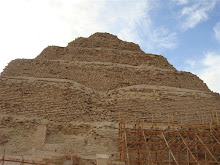In the run-up to 2012, what should worry us more - the vast expense of hosting the Olympics or the end of the world?
Whichever way you look at it, 2012 is likely to be a significant year for Londoners.
Come the summer of that year, that bottomless money pit of a building site will be transformed into an Olympic wonderland.
Then, as we approach the winter solstice, the end of the world could well be nigh, according to Mayan prophecy.
This ancient culture warned of the "End of Days" - a phrase which has about as many interpretations as a Nostradamus quatrain.
In mathematical terms, 2012 marks the end of a cycle of around 26,000 years in the Mayan calendar.
When the calendar was created, the Mayans were envisioning a future so distant that they could have had no concrete concept of what it would actually be like.
Their world view was a cyclical one - spring follows winter, sunrise gives way to sunset, civilisations rise and fall.
It could be argued that their prophecies of death, destruction, and the end of the world by natural disaster were pure speculation, based on canny calculation.
Calling it the End of Days makes it sound like time is running out - but rather than the end of the world, maybe the sign of our times is a shift in our perception of time itself.
Given the rapid pace of technological progress, we could be on the brink of a quantum leap in our understanding of the space-time continuum and our place in the universe.
The advent of the Hadron collider, generator of a vast shake-up of atomic particles and our view of how they operate, means the accepted laws of physics could be overturned. (While Halo's progress was temporarily tarnished by a spanner in the works, hopefully its ring of confidence will soon be restored.)
This raises the question of what matter is, and how much the material world actually matters.
This is not just thinking outside the box, but wondering whether the box itself actually exists.
Without physical matter, there can be no concept of time. An awareness of the limitations of the material way of life encourages us to contemplate a more spiritual side to existence.
For the religious, we could well be having our Apocalypse now, Armageddon and the Second Coming being another couple of options.
From the non-denominational standpoint of the slightly spiritual, the current state of the world is a kind of karmic come-uppance.
For others, a sense of impending doom echoes the words of Einstein:
"I know not with what weapons the third World War will be fought. But the fourth will be fought with sticks and stones."
In this era of accelerated communication, we know how flawed predictive texting can be, let alone predicting the future.
If it seems unwise to jump to conclusions based on a single source of information, let's compare the Mayan prophecies with one from the Maoris.
According to one Maori legend, 2012 is the time of "ka hinga te arai" which means the fall of the curtain, or veil.
Before we prepare to face "the final curtain", it's worth bearing in mind the alternative interpretation - a "lifting of the veil" which could suggest a change in our world view.
The future is not set in stone. There are infinite possibilities, but as in a chess game, each new move draws us closer to a particular outcome.
So let's make sure we make all the right moves towards the outcome we want - to save the planet.
If Gaia's natural balance is out of kilter, let's do what we can to rectify that, before she carries us away with her own cleansing programme of natural disasters.
If a corrupt system needs dismantling, if outdated practices and ways of thinking need to be swept away, so be it. Chances are this may happen, whether we like it or not, so best go with the flow.
No-one knows exactly what 2012 will bring. But what we do know is that whatever happens in the world is up to us. We are the co-creators who determine its fate. The earth's future is in our hands.
Monday, 18 May 2009
Thursday, 14 May 2009
Daydreaming can be inspiring
Day dreamers aren't just drifters, they're applying their minds to solving complex problems, according to the latest research.
"Mind wandering is typically associated with negative things such as laziness or inattentiveness, but our study shows our brains are very active when we daydream - much more active than when we focus on routine tasks," says Prof Kalina Christoff, who led the study at British Columbia University.
"Mind wandering is typically associated with negative things such as laziness or inattentiveness, but our study shows our brains are very active when we daydream - much more active than when we focus on routine tasks," says Prof Kalina Christoff, who led the study at British Columbia University.
Tuesday, 5 May 2009
The darkness behind our obsession with doom
The dark undercurrents of doom and gloom in the media.
blogs.telegraph.co.uk/justin_williams
blogs.telegraph.co.uk/justin_williams
Subscribe to:
Comments (Atom)
